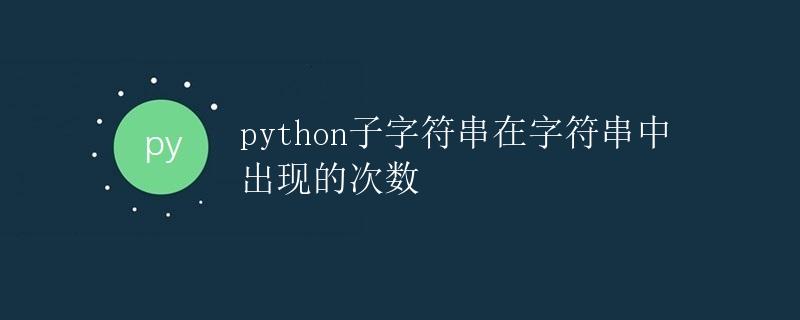Python子字符串在字符串中出现的次数

在处理字符串时,经常会遇到需要统计一个子字符串在给定字符串中出现的次数的情况。Python提供了多种方法来实现这个功能,本文将详细介绍这些方法并通过示例代码来演示它们的用法。
方法一:使用count方法
Python的字符串对象提供了count方法来统计一个子字符串在字符串中出现的次数。该方法的语法如下:
count = string.count(sub_string)
其中string是需要搜索的字符串,sub_string是要统计出现次数的子字符串。该方法返回子字符串在字符串中出现的次数。
下面是一个示例代码,演示了如何使用count方法来统计子字符串在字符串中出现的次数:
# 定义一个字符串
string = "hello world hello hello"
# 定义子字符串
sub_string = "hello"
# 使用count方法统计子字符串出现的次数
count = string.count(sub_string)
# 输出结果
print(f"The substring '{sub_string}' appears {count} times in the string.")
运行以上代码将输出:
The substring 'hello' appears 3 times in the string.
方法二:使用find和循环
另一种方法是使用find方法结合循环来统计子字符串在字符串中出现的次数。该方法的原理是通过不断地调用find方法来定位子字符串的位置,并在每一次找到子字符串后将搜索的起始位置向后移动。
下面是一个示例代码,演示了如何使用find方法和循环来统计子字符串在字符串中出现的次数:
# 定义一个字符串
string = "hello world hello hello"
# 定义子字符串
sub_string = "hello"
# 初始化计数器和起始位置
count = 0
start = 0
while True:
# 在剩余的字符串中查找子字符串
index = string.find(sub_string, start)
if index == -1:
break
# 更新起始位置并增加计数器
start = index + 1
count += 1
# 输出结果
print(f"The substring '{sub_string}' appears {count} times in the string.")
运行以上代码将输出:
The substring 'hello' appears 3 times in the string.
方法三:使用正则表达式
最后一种方法是使用正则表达式来统计子字符串在字符串中出现的次数。Python的re模块提供了强大的正则表达式操作功能,通过使用re.findall方法可以轻松地找到字符串中所有符合条件的子字符串。
下面是一个示例代码,演示了如何使用正则表达式来统计子字符串在字符串中出现的次数:
import re
# 定义一个字符串
string = "hello world hello hello"
# 定义子字符串
sub_string = "hello"
# 使用正则表达式查找子字符串
matches = re.findall(sub_string, string)
# 统计匹配的数量
count = len(matches)
# 输出结果
print(f"The substring '{sub_string}' appears {count} times in the string.")
运行以上代码将输出:
The substring 'hello' appears 3 times in the string.
总结
本文介绍了三种方法来统计子字符串在字符串中出现的次数:使用count方法、使用find方法结合循环和使用正则表达式。不同的方法适用于不同的场景,可以根据具体情况选择合适的方法来实现字符串操作。在实际开发中,根据字符串的规模和复杂度,选择性能更好的方法来处理字符串操作是非常重要的。
 极客教程
极客教程